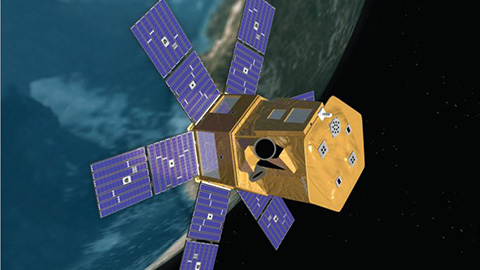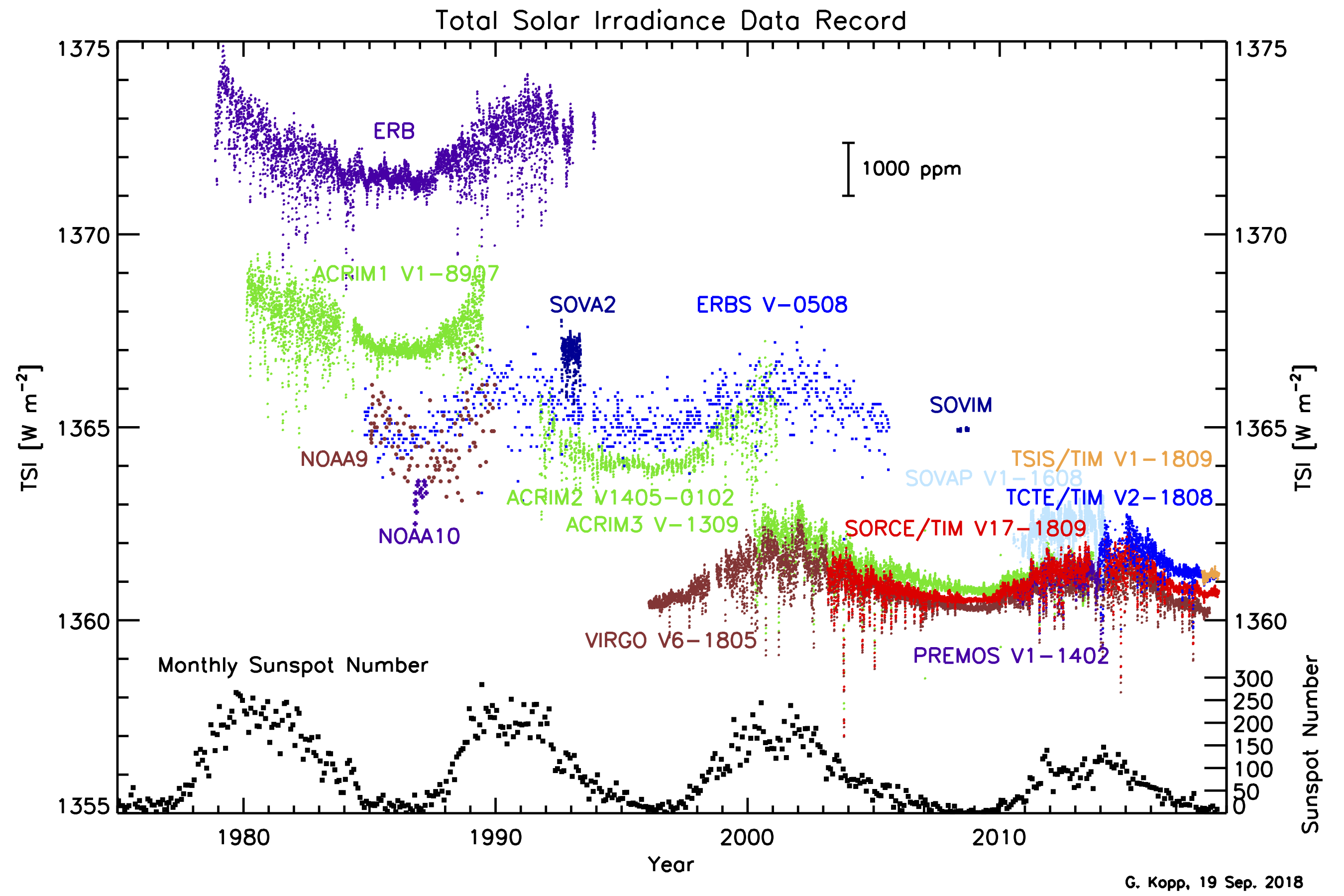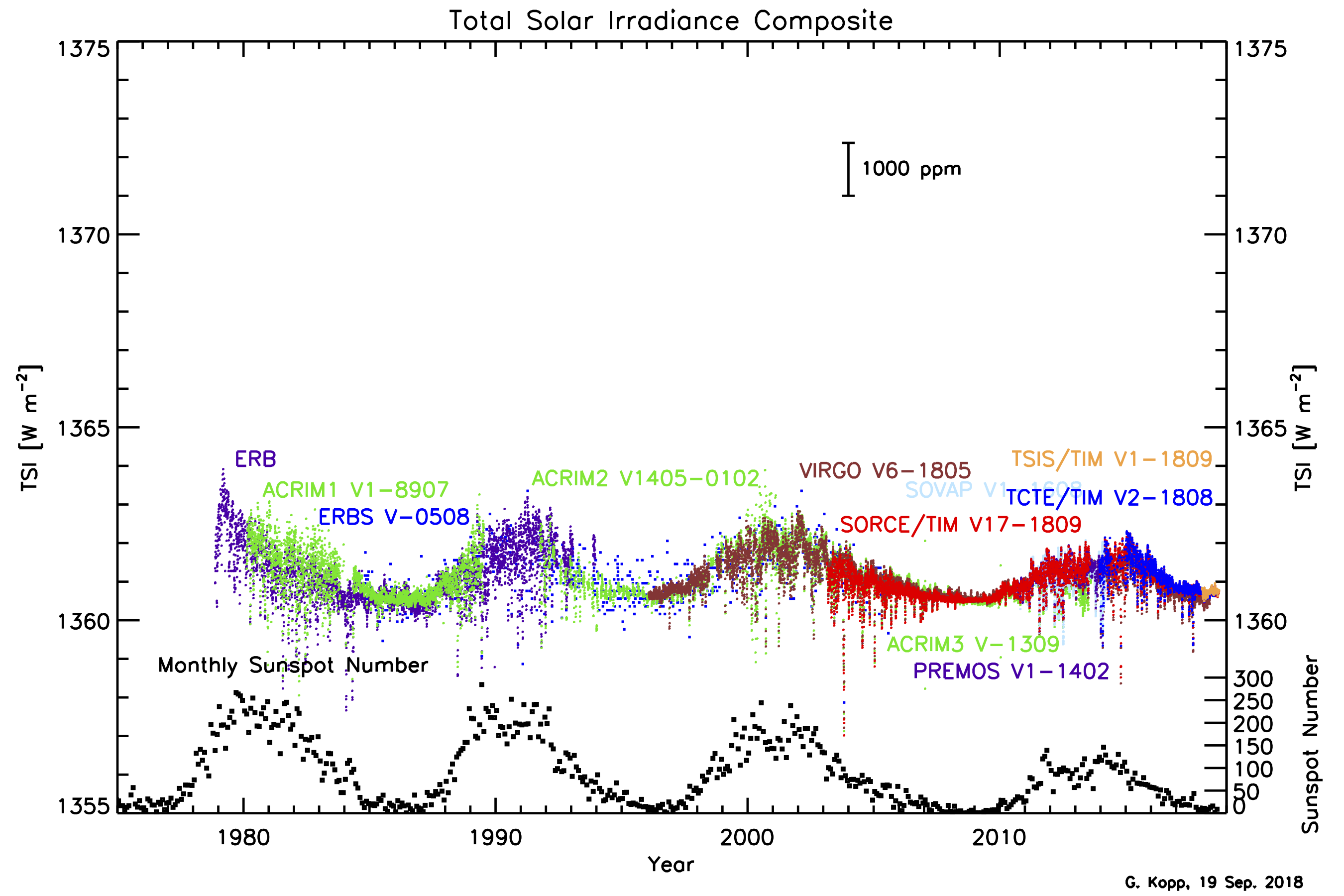Solar Radiation and Climate Experiment

Solar Radiation and Climate Experiment
The Solar Radiation and Climate Experiment (SORCE) is a NASA-sponsored satellite mission that is providing state-of-the-art measurements of incoming x-ray, ultraviolet, visible, near-infrared, and total solar radiation. The measurements provided by SORCE specifically address natural variability and enhanced climate prediction, and atmospheric ozone and UV-B radiation. These measurements are critical to studies of the Sun; its effect on our Earth system; and its influence on humankind.
The SORCE spacecraft was launched on January, 2003
The TSI Calibration Transfer Mission (TCTE) was launched in 2013 on the Air Force Space Test Program spacecraft known as STPSat-3, and TCTE is intended as a bridge for the TSI record between the aging SORCE and future NASA Total and Spectral Solar Irradiance Sensor (TSIS) mission. This proposal is for the extension of SORCE and TCTE missions in order to accommodate their overlap with the TSIS-1 mission that is expected to launch no earlier than November 2017.
The TSI and SSI records are essential components of the national climate program as discussed in the NRC Earth Science and Applications from Space report [2007] and in the NASA Science Plan [2014]. As recognized in the recent IPCC AR5 [2013], “there is very low confidence concerning future solar forcing estimates”, so continuation of the solar irradiance measurements and improvements in their accuracy are needed. Furthermore, because gaps in the TSI or SSI record significantly degrade the accuracy of the long-term (decadal) variation of the solar irradiance, it is critical to continue the SORCE and TCTE observations to overlap with the future TSIS TSI and SSI measurements. The TSIS-1 is being developed for the International Space Station (ISS), and its observations are expected to begin in early 2018.

Three key accomplishments of the SORCE and TCTE missions are (1) the continuation of the 38-year-long TSI record; (2) the continuation of the ultraviolet (UV) SSI record; and (3) the initiation of the near ultraviolet (NUV), visible (Vis), and near infrared (NIR) records. The science merit and recent accomplishments for SORCE and TCTE missions are presented in Section 1. The key motivation to extend the SORCE and TCTE missions into 2018 is to provide a critical overlap with the new SSI and TSI observations from TSIS-1, thereby ensuring continuity as recommended in the NRC report Continuity of NASA Earth Observations from Space [2015]. In addition, this next extended mission is important for observing the next solar cycle minimum in ~2018; such observations with the same instruments used to measure the 2008 minimum are expected to bring unprecedented estimates for possible secular trends of the solar irradiance. Furthermore, the SORCE measurements of the H I emission at 121 nm and the Mg II core-to-wing index at 280 nm are important products for NOAA and Air Force space weather operations.
All of the SORCE and TCTE instruments remain functional and in good health and are expected to perform well during the extended mission as described in Section 2. The SORCE instruments currently all operate on the daylight part of each orbit and are powered-off during orbit eclipse because the spacecraft battery capacity has decreased after some battery cells developed shorts. Despite instruments having larger temperature variations in this power-cycling mode, SORCE continues to provide high quality TSI and SSI products that meets requirements. Data processing algorithms that convert raw instrument signals to irradiances are very mature. Ongoing analysis of instrument degradation trends and algorithm updates to accommodate changes in spacecraft operations will ensure that the most accurate final data products will be generated during Phase F.
The SORCE spacecraft (S/C) is a robust Orbital ATK S/C that is capable for this extended mission. Degradation of battery performance has impacted operations since 2009 and is the cause for the largest SORCE data gap (Aug. 2013-Feb. 2014). Flight software updates returned SORCE to science observations in March 2014. This SORCE operations mode, called “Daylight Only Operations” (DO-Op) mode, has allowed SORCE to resume making solar observations during most orbits, and this mode has furthermore stabilized the battery during the past three years. SORCE has also successfully operated in brown-out mode when all subsystems are off during eclipse and then recover autonomously at orbit sunrise to continue solar observations. We expect to be able to operate SORCE in its DO-Op mode for at least three more years as presented in more detail in Section 2 and Appendix E-1.
The TCTE is flying on the Air Force STPSat-3, which was launched on Nov. 19, 2013. Although STPSat-3 was initially planned for a short technology-demonstration mission, NOAA has been funding the Air Force to extend the STPSat-3 mission operations to continue the TCTE TSI measurements. The health of the STPSat-3 is excellent. In 2017, NASA is assuming responsibility of continued STPSat-3 TCTE operations.
The SORCE and TCTE missions have proven to be highly cost effective PI-led missions that benefit from stable staffing of personnel with broad experience in space instrumentation, mission operations, data processing, and financial management. These programs also benefit from hiring the University of Colorado’s brightest students for spacecraft operations and data analysis, thereby inspiring and training the future space science and aeronautical workforce. These factors ensure that SORCE and TCTE extended missions will be equally successful, even with the risks and uncertainties associated with aging spacecraft.
SORCE carries four instruments including the Spectral Irradiance Monitor (SIM), Solar Stellar Irradiance Comparison Experiment (SOLSTICE), Total Irradiance Monitor (TIM), and the XUV Photometer System (XPS).
SORCE/TIM and TCTE Mission Highlights
The SORCE/TIM Determines a New, Lower Value of TSI Than Previous Measurements. Prior to the SORCE launch in 2003, on-orbit TSI instruments agreed with each other in measured TSI values near 1365 W/m^2 near solar minima. The new SORCE/TIM, including many optical, electrical, and calibration improvements over these prior instruments, measured values 0.35% lower than the other on-orbit instruments (see left-hand figure below). Initially disregarded by the community as an error in the TIM instrument, this difference has recently been shown to be due to uncorrected scatter causing erroneously high measurements by other instruments, all of which have an optical design that differs from the TIM by allowing two to three times the amount of light intended for measurement into the instrument. The TIM, placing the instrument's small precision aperture at the entrance, only allows the light intended for measurement into the instrument interior, and hence is much less susceptible to scattered light.
Diagnostics with the TSI Radiometer Facility (Kopp et al., SPIE, 2007) of ground-based instruments representative of those on orbit have demonstrated that the scatter in non-TIM instrument designs is the primary cause of the higher readings by the other instruments. Applying scatter corrections to these instruments' data brings their values down to those measured by the TIM, which reports a value of 1360.8 W/m^2 representative of the 2008 solar minimum (Kopp & Lean, 2011) (see right-hand figure below). This new lower TSI value reported initially by the SORCE/TIM has also been validated with the recently launched PICARD/PREMOS (brown data in right-hand plot below) and the TCTE/TIM (blue data in left-hand plot below), both of which were calibrated on the TSI Radiometer Facility prior to launch.
SORCE/SIM Mission Highlights
Two major accomplishments of the SORCE/SIM are (1) the continuation of the ultraviolet (UV) SSI record and (2) the initiation of the near ultraviolet (NUV), visible (Vis), and near infrared (NIR) records.

Figure 1a Total Solar Irradiance Data Record (G. Kopp, Feb. 2017)

Figure 1b. Total Solar Irradiance Composite (G. Kopp, Feb. 2017)

